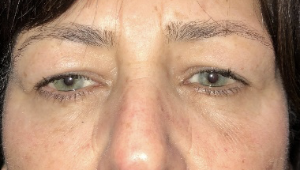Extra eyelid skin or fat, droopy eyelid
Dermatochalasis, ptosis
Aging and genetics can affect the eyelids, making vision more difficult or changing someone’s appearance.
Ptosis – (pronounced “tosis”, drooping of the upper eyelids) can either be mild and cosmetic or more significant interfering with sight and peripheral vision. Ptosis can affect adults or children and is treated surgically by lifting the eyelid (ptosis repair). In children surgery may be needed to allow development of normal vision. There are various surgical techniques that can lift the eyelid and your surgeon will go over these with you and help decide which is best.
Dermatochalasis - (excess eyelid skin) is often described as a “tired look” or “bags”. It is treated surgically by blepharoplasty. Upper eyelid blepharoplasty is sometimes covered by insurance if severe enough to interfere with vision, while lower eyelid blepharoplasty is typically cosmetic. This will be evaluated at the time of your initial appointment. Blepharoplasty removes excess eyelid skin and adjusts any extra fat if needed. The procedure can improve wrinkles, bags and the dark circles under the eyes. The surgery redefines the shape of the eye and gives a more youthful and refreshed appearance. Upper blepharoplasty is performed through an eyelid crease incision which is hidden with little to no scarring. Lower eyelid blepharoplasty can be performed through an incision on the inside of the eyelid or an external incision that is hidden below the lash line.
Ptosis repair and blepharoplasty are performed on an outpatient basis. It typically takes 1-3 weeks for bruising to disappear fully, although makeup or sunglasses can provide effective cover.
|
Before |
After right ptosis repair |
|
Before |
After upper blepharoplasty and ptosis repair both eyes |
|
Before |
After upper blepharoplasty both eyes |
|
Before |
After upper blepharoplasty both eyes |







